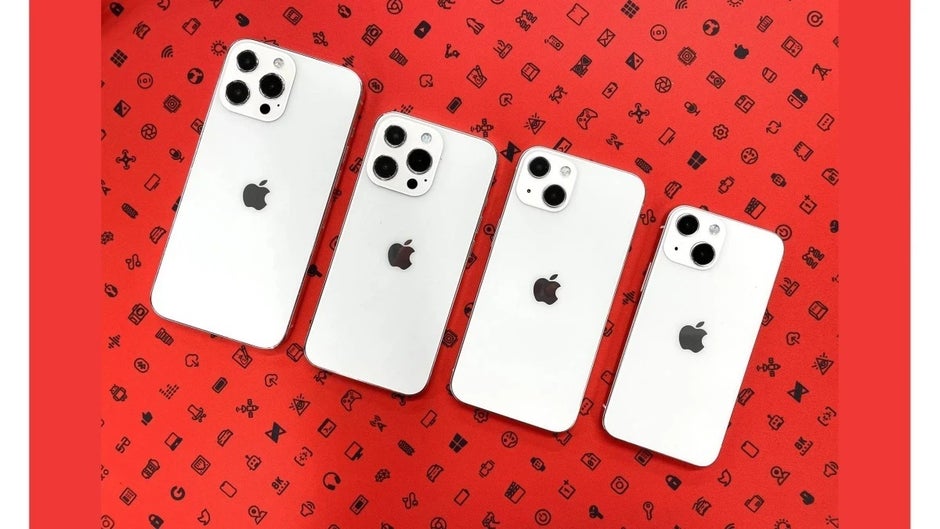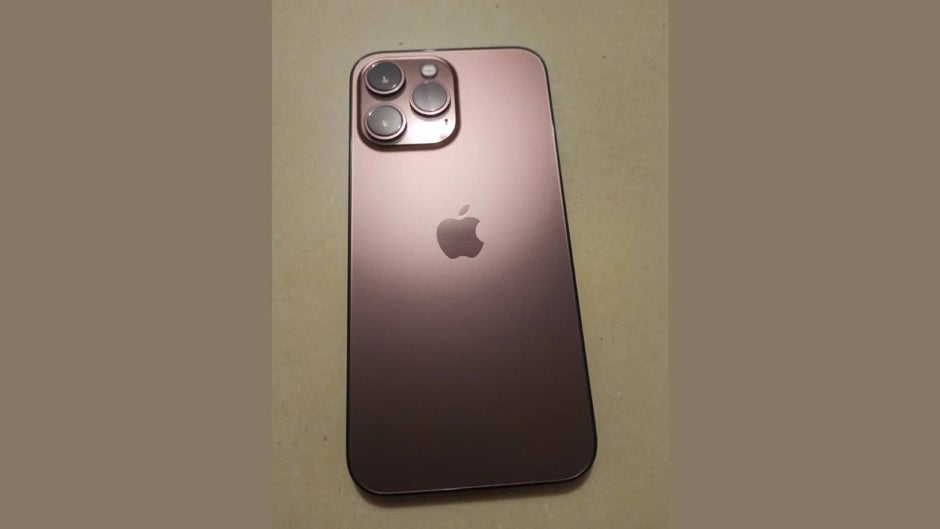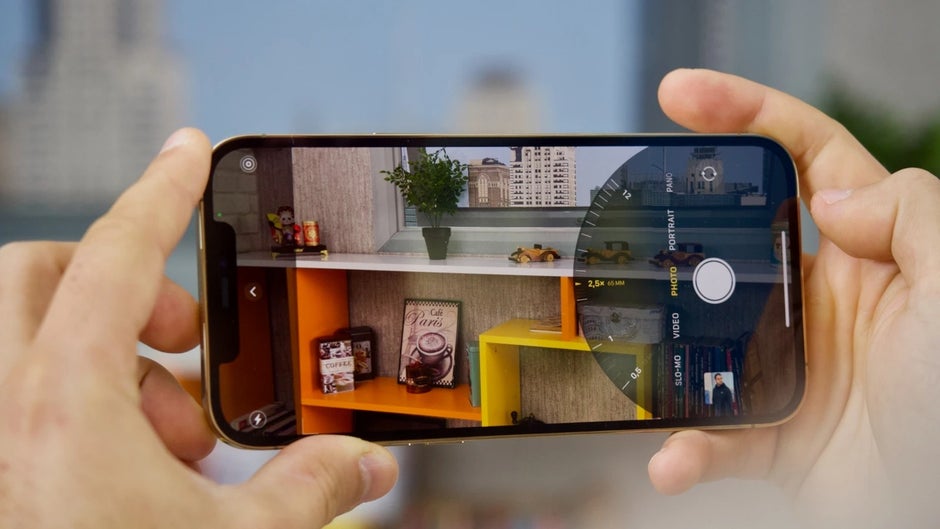Apple iPhone 13 Pro Max vs iPhone 13 Pro
Apple iPhone 13 Pro Max vs iPhone 13 Pro display size and refresh rate
At first brush, the choice between the two phones couldn’t be more obvious – take the Pro if you want a compact phone, grab the Max if you don’t mind a huge flagship with all the bells and whistles. The difference in the sizing, however, is also a difference in pricing and features, so the choice is not as clear-cut.

Dummy iPhone 13 series units
First off, the 6.7″ 2778 x 1284 pixels and 6.1″ 2532 x 1170 pixels display sizes and resolution of the iPhone 13 Pro Max and 13 Pro are not expected to change from their predecessors. What will change, however, is the display’s technology. Instead of the oldie LTPS panels of the 12 series, the 13 Pro models are to sport modern frugal LTPO OLED screens that allow for a variable refresh rate depending on the content shown.
In an LTPO display the switching element is replaced with an oxide among several transistors which reduces the leakage current and lowers the power consumption by 15-20% to somewhat compensate for the higher power draw of the 120Hz refresh.
Apple iPhone 13 Pro/Max vs iPhone 12 Pro colors
Apple iPhone 13 Pro and 13 Pro Max colors list:
- Black
- Silver
- Rose gold (pale and subtle)
- Sunset gold (bronze feel)
As you can see, this is a radical departure from the Gold, Pacific Blue, Silver, and Graphite iPhone 12 Pro options. Graphite goes black, silver remains silver, and both golden options will differ from the iPhone 12 Pro Gold hue.
Supply chain sources claim that the iPhone 13 Pro’s mysterious Sunset Gold edition is leaning more towards the bronze side of the spectrum, while the Rose Gold, which Apple has used plenty of times before in its iPhones, is very pale and subtle this time around.

Alleged Rose Gold iPhone 13 Pro
With the Chinese love of all things golden, the iPhone 13 Pro color set may undergo a thorough transformation when the phones land stateside, so the mystery of the fourth color that will most likely not be Sunset or Rose gold in the US, remains. Which one would you pick?
Is the iPhone 13 Pro/Max waterproof?
- Yes, up to 20 feet for up to 30 minutes
Apple may have been late to the iPhone water-resistance game, but it now prides itself in providing one of the toughest waterproofing standards of all phones barring specialized tough and durable models.
The iPhone 12 series, for instance, have IP68 rating like most of them water-resistant phones, but they can dive up to much deeper, 19.6 feet (six meters) depths of water for 30 minutes compared to virtually all other waterproof handsets.
Not that the others can’t withstand such pressure, but anecdotally and not in an official specs list as Apple touts its wares. The iPhone 13 Pro Max and 13 Pro are unlikely to dive any deeper, though, so even though they will be waterproof, they’ll be able to lounge at the 20 feet bottom of a fresh water lake for at least half an hour still.
Apple iPhone 13 Pro Max vs iPhone 13 Pro cameras
- iPhone 13 Pro camera specs: 12MP main with F1.6 aperture and 1.7 μm pixels, 12MP f/1.8 ultrawide w/ autofocus and 12 MP 2.5x telephoto
- iPhone 13 Pro Max camera specs: 12MP main with F1.5 aperture and >1.7 μm pixels, 12MP f/1.8 ultrawide w/ autofocus and 12 MP 3x telephoto
Perhaps the biggest change apart from the 120Hz ProMotion displays of the iPhone 13 Pro and 13 Pro Max, compared to their lowly iPhone 13 and iPhone 13 mini brethren, is in the camera department.

iOS camera app
The iPhone 13 Pro/Max will supposedly have a 3.65mm thick camera island and the iPhone 13 will feature a 2.51mm bump. For the iPhone 12 and 12 Pro, these figures are between 1.5mm and 1.7mm. The iPhone 13 Pro models are also expected to have a significantly larger camera bump. The current models have a 28mm by 30mm bump approximately and the size will reportedly increase slightly to 29mm by 29mm on the iPhone 13. It will also be moved a millimeter closer to the top. Why the change?
Well, both upcoming Pro models will have sensor-shift stabilization, something which is exclusive to the iPhone 12 Pro Max at the moment. Reports say that the company will include the tech for both the Wide and Ultra-Wide lens. The iPhone 13 Pro, on the other hand, is also rumored to inherit iPhone 12 Pro Max’s upgraded telephoto module and larger sensors for better low-light sensitivity.
The 13 Pro Max camera sensor, on the other hand, will be bigger than the one in the 12 Pro Max, hence the 13 Pro, warranting a larger bump, so the biggest difference between the Pro and Max will again be the best camera hardware Apple has ever placed in an iPhone.
It seems that Apple will again set the Pro Max model apart from the rest of the iPhone 13 crowd by equipping it with a better main camera with larger sensor and wider lens. The lens aperture of the iPhone 13 Pro Max’s main camera will widen to f/1.5 from the current f/1.6 on the 12 Pro Max, letting more light in, and potentially improving night and indoor photography with the handset.
Moreover, both will have autofocus on the ultra-wide cameras instead of the fixed focus that the respective iPhone 12 series camera have now. You can not decide where you want the camera to focus with fixed focus, while the autofocus gives you that possibility.
Apple iPhone 13 Pro Max vs iPhone 13 Pro performance
- Second generation 5nm Apple A15 processor
- TSMC N5P production method
- Up to 7% performance gains compared to A14
- Or, up to 15% power draw reduction
That’s because Apple is keeping the 3nm/4nm process for next year’s iPhones and iPads, while the Apple A15 will still be a 5nm affair, just an enhanced one with the second generation of the TSMC foundry’s 5nm node.
As a rule of thumb, those second-gen tapeouts further refine the gains achieved with the first generation, as happened with the 7nm process, rather than introduce some breathtaking technology jumps which are getting harder and harder with each production node shrink.
During the N5P introduction to investors, TSMC stated that the second generation process node will let manufacturers pick either a a 15% better power efficiency, or 7% performance boost.
Apple will most likely try to balance both, so expect about 10% iPhone 13 Pro Max and 13 Pro performance gains with Apple 15 compared to their predecessors at a 10% lower power draw, and that’s that. Apple, as usual, may focus more on the AR/VR, AI, imaging, video, and other buzzword coprocessing, rather than pure power gain, as the A14 is already strong enough like Cher.
Apple iPhone 13 Pro Max vs iPhone 13 Pro battery life and charging
Last but not least among the main iPhone 13 Pro Max vs iPhone 13 Pro differences is the battery size. This year, Apple will have placed the largest iPhone batteries ever in those two, not that the 12 Pro Max wasn’t doing great in our battery benchmark anyway but still – 120Hz displays and all – despite that they will be of the frugal LTPO variety.
Thus ,if iPhone battery life is a pet peeve for you, and you are worried about the new power-hungry displays, the iPhone 13 series could feature a huge jump in battery size making you very happy. The 13 Pro Max model could sport a 4352mAh battery which would be an 18% hike from last year’s iPhone 12 Pro Max.
The iPhone 13 and iPhone 13 Pro could see their battery capacities jump 10% from 2815mAh to 3095mAh, and the iPhone 13 mini is rumored to sport a 2406mAh battery (up 8% from the 2227mAh battery used on the iPhone 12 mini).
Besides the larger batteries (which would make the 2021 models a little thicker), this year’s phones will be powered by the A15 Bionic chipset that will reportedly bring savings of 15% to 20% in power consumption, as mentioned. Add this together with the rumored new battery sizes, and iPhone 13 series users just might be happy with the battery life on their new iOS phones.
For all the latest Technology News Click Here
For the latest news and updates, follow us on Google News.

